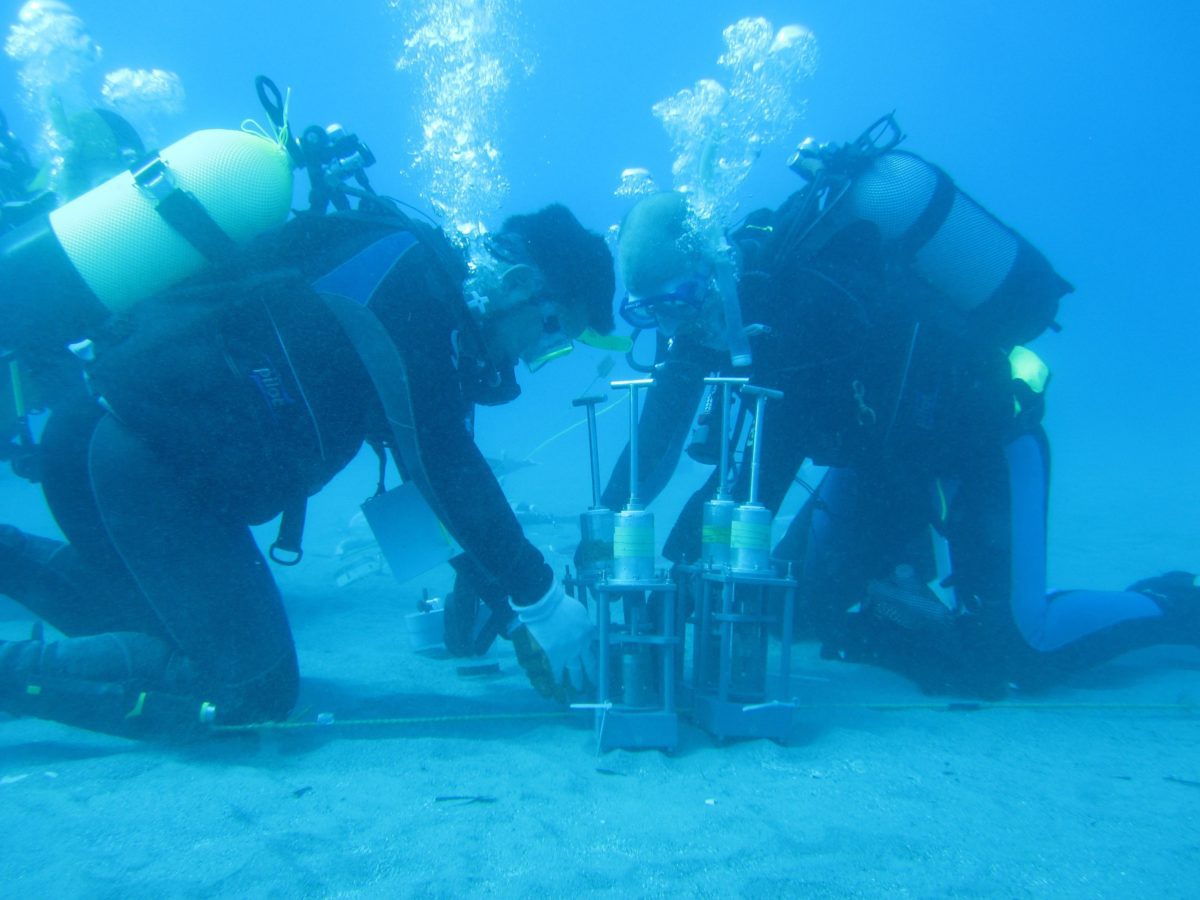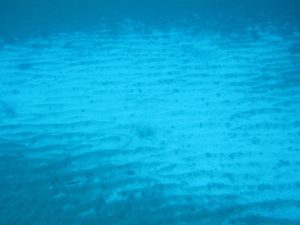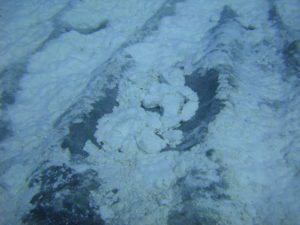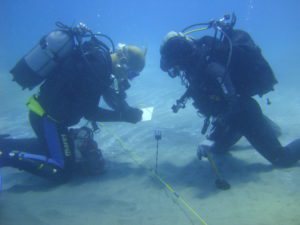Fluid Flow Stimulates Chemosynthesis in a Greek Salad of Hydrothermal Microbes
 WHOI’s Phil Arevalo (left) and Stefan Sievert remove one of the incubation devices used to measure the activities of the chemosynthetic microbes from the sediment. The incubation devices were originally built in the 1980’s by WHOI’s Carl Wirsen and Holger Jannasch and were part of a free-falling instrument to measure the activities of microorganisms breaking down organic matter in deep-sea sediments. For the present study, they were adapted to be used by scuba divers. (Photo credit: Dr. Costantino Vetriani, Rutgers University)
WHOI’s Phil Arevalo (left) and Stefan Sievert remove one of the incubation devices used to measure the activities of the chemosynthetic microbes from the sediment. The incubation devices were originally built in the 1980’s by WHOI’s Carl Wirsen and Holger Jannasch and were part of a free-falling instrument to measure the activities of microorganisms breaking down organic matter in deep-sea sediments. For the present study, they were adapted to be used by scuba divers. (Photo credit: Dr. Costantino Vetriani, Rutgers University) April 22, 2022
New paper by Woods Hole Oceanographic Institution researchers studies shallow-water hydrothermal systems and the production of microbes
Woods Hole, MA — Most visitors to Paliochori Beach on the Greek island Milos may not be aware of the bay’s shallow-water hydrothermal community, a veritable Greek salad of microbes, that is within snorkeling distance from the shoreline.
The hydrothermalism in the coastal sediments of Paliochori Bay strongly affects biogeochemical processes there and supports chemosynthesis, which allows certain microorganisms such as sulfur-oxidizing bacteria to use chemical energy rather than light, as photosynthetic plants or algae do, to convert carbon dioxide into cell material.
However, the impact of fluid flow on the composition of the microbial community and the rates of chemosynthetic production have been unknown because it is challenging to measure microbial processes under natural conditions, particularly in hydrothermal systems.
A new study uses an innovative approach to examine the bay’s shallow-water hydrothermal system and the production of microbes there in situ and near natural conditions as a model to assess the importance of hydrothermal fluid circulation on chemosynthesis.

The areas of hydrothermal activity in Paliochori Bay are delineated by white mats forming on top of the sandy sediments. These mats are formed by chemosynthetic microbes which grow at the interface between the oxygen-rich seawater and the sulfide-laden hydrothermal fluids seeping up from below the seafloor. Maintaining this flow during the incubations is key to measure the productivity of the chemosynthetic microbes. (Photo credit: Dr. Costantino Vetriani, Rutgers University)
By examining microbial communities directly within the hydrothermally-impacted sandy sediments in the bay, the study demonstrates “the importance of fluid flow in shaping the composition and activity of microbial communities of shallow-water hydrothermal vents, identifying them as hotspots of microbial activity,” according to the paper, “Fluid flow stimulates chemoautotrophy in hydrothermally influenced coastal sediments,” published in Communications Earth & Environment, a Nature Portfolio journal.
In addition, “the study shows how productive the shallow water hydrothermal vents actually are, and how quickly the microbes adapt to changing conditions,” says co-lead author Stefan Sievert, associate scientist in the Woods Hole Oceanographic Institution’s (WHOI’s) Biology Department.
During the study, researchers carried out two sets of stable isotope probing experiments using carbon dioxide labelled with the stable carbon isotope 13C as a tracer to determine the microbes’ capability for carbon fixation, which is the conversion of carbon dioxide into biomass. The study deployed incubation devices along a transect at a vent in the bay and injected the tracer at different depths into the sediment, either in open or closed fluid flow modes, and left the devices in place for either 6 hours or 24 hours before picking them up again.
The amount of carbon fixation was determined by measuring the incorporation of the labelled carbon dioxide into fatty acids, a key component making up the cell membrane, in combination with assessing the composition of the microbial community using DNA- and RNA-based approaches.
The study “extends the current knowledge on dark carbon fixation in coastal sandy sediments to those areas that are impacted by hydrothermal activity,” according to the paper. The researchers’ data reveal that active fluid flow at this sandy sediment shallow-water hydrothermal vent site sustains carbon fixation rates that are among the highest determined for coastal margin sediments, highlighting the influence of hydrothermalism in supporting chemoautotrophic production by supplying the required chemicals in the form of electron donors such as hydrogen sulfide, and acceptors such as oxygen.

When conditions are calm, the mats can grow up to an inch in thickness. During storms, the mats get swept away, providing a mechanism to export the produced biomass to the surrounding ocean, where it can serve as food for organisms. (Photo credit: Dr. Roy Price, Stony Brook University)
Extrapolating the production at the studied vent site to the overall venting area in the bay of about 4 acres, 7 metric tons of carbon are produced there per year. “That is about the same annual production per area as a 4-acre corn field,” says Sievert.
The study also found a very active microbial community that is able to respond quickly to environmental changes. The chemosynthetic production at Milos is mainly driven by Campylobacteria, which dominated the communities in the open incubations, but declined in the closed incubations. Other bacteria, in particular Gammaproteobacteria, also increased in open flow incubations, while others, such as Deltaproteobacteria and Thermodesulfobacteria increased in closed incubations. In general, the community switched from a community dominated by chemosynthetic microbes to one with a higher proportion of heterotrophic microbes, i.e., microbes that use organic carbon for food, just as people do. The study found that the microbial community changed in response to different conditions within a matter of hours, which is very fast and took the investigators by surprise.
Making the microbe rate measurements and identifying the various microbes at the hydrothermal vent site was a collaborative effort. That collaboration included Sievert’s expertise in the use of the incubation device and identifying the microbes based on DNA- and RNA-based techniques. In addition, the lab of co-lead author Solveig Bühring, a researcher at the University of Bremen, contributed data on the incorporation of the labelled carbon dioxide into the microbes’ fatty acids.
“What drives me to do this research is my curiosity to understand how things work. I’m interested in knowing what the microbes are doing and how they are helping the ecosystem to function,” says Sievert.
“Each individual microbe is so small, yet their combined impact is so immense,” he adds. “Microbes are kind of the engines of our planet, basically driving all of the biogeochemical cycles, such as the nitrogen and sulfur cycles.”

WHOI’s Stefan Sievert (left) and his collaborator Costantino Vetriani from Rutgers University measure temperature profiles in the sediments. The temperature probe (between the two divers) is inserted into the sediment at predefined intervals and the temperature recorded. (Photo credit: Dr. Roy Price, Stony Brook University).
This work was funded by the National Science Foundation (NSF, USA) through grant OCE-1124272 and by the Deutsche Forschungsgemeinschaft through the Emmy Noether-Program. In addition, Sievert received support from the WHOI Investment in Science Fund. The authors are also grateful to the General Directorate of Antiquities and Cultural Heritage in Athens for granting them permission for sample acquisition and processing.
Authors: Stefan M. Sievert1¶*, Solveig I. Bühring2¶*, Lara K. Gulmann1, Kai-Uwe Hinrichs3, Petra Pop Ristova2, Gonzalo V. Gomez-Saez2
Affiliations:
1Biology Department, Woods Hole Oceanographic Institution, Woods Hole, MA USA
2Hydrothermal Geomicrobiology Group, MARUM – Center for Marine Environmental Sciences, University of Bremen, Bremen, Germany
3Organic Geochemistry Group, MARUM – Center for Marine Environmental Sciences & Department of Geosciences, University of Bremen, Bremen, Germany
¶These authors contributed equally
*corresponding authors
###
About Woods Hole Oceanographic Institution
The Woods Hole Oceanographic Institution (WHOI) is a private, non-profit organization on Cape Cod, Massachusetts, dedicated to marine research, engineering, and higher education. Established in 1930, its primary mission is to understand the ocean and its interaction with the Earth as a whole, and to communicate an understanding of the ocean’s role in the changing global environment. WHOI’s pioneering discoveries stem from an ideal combination of science and engineering—one that has made it one of the most trusted and technically advanced leaders in basic and applied ocean research and exploration anywhere. WHOI is known for its multidisciplinary approach, superior ship operations, and unparalleled deep-sea robotics capabilities. We play a leading role in ocean observation and operate the most extensive suite of data-gathering platforms in the world. Top scientists, engineers, and students collaborate on more than 800 concurrent projects worldwide—both above and below the waves—pushing the boundaries of knowledge and possibility. For more information, please visit www.whoi.edu
Key Takeaways
- The hydrothermalism in the coastal sediments of Paliochori Bay strongly affects biogeochemical processes there and supports chemosynthesis, which allows microorganisms to use chemical energy rather than photosynthesis to convert carbon dioxide to biomass.
- The impact of fluid flow on the composition of the microbial community and the rates of chemosynthesis production have been unknown because it is challenging to measure microbial processes under natural conditions, particularly in hydrothermal systems.
- A new study used an innovative approach to examine the bay’s shallow-water hydrothermal system and the production of microbes there in situ and near natural conditions as a model to assess the importance of hydrothermal fluid circulation on chemosynthesis.
- By examining microbial communities directly within the hydrothermally-impacted sediment in the bay, the study demonstrates the importance of fluid flow in shaping the composition and activity of microbial communities of shallow-water hydrothermal vents.
- The study shows how productive the shallow water hydrothermal vents actually are, equal to the production of a corn field, and how quickly the microbes adapt to changing conditions.
